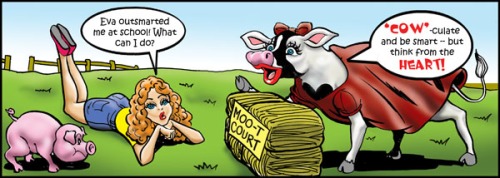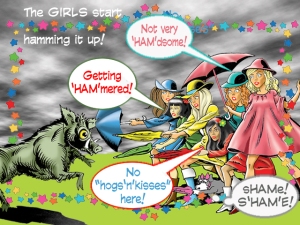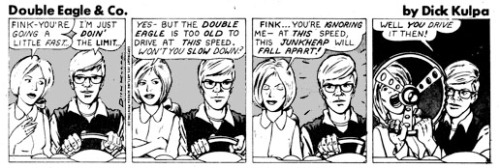Captain Cartoon’s long artistic career began when the “Silver Age of Comics” so permeated his brain that he nearly became a cartoon character himself, even collecting coke bottles in groups of six to trade for a 12 cent comic. At age 13, he launched a Memphis, Tenn.-based lawn-mowing business to finance his habit, with an eye toward mowing Elvis Presley’s Graceland lawn.
Once upon a time, “comic books” were a staple in every household, with ragged editions strewn across floors, beds and shelves in virtually every kid’s bedroom in the 1960s and before.
Not any more.
Lots of reasons have been offered for the comics’ descent from mainstream consciousness, ranging from editorial shifts to changing demographics to a diminishing reader interest. But I can recall my experiences — as a devout comic book consumer (specifically Marvel) back when the so-called “Silver Age of Comics”, a term applied to the 1950s – 60s resurgence in comics popularity , ended.

Here's a digital drawing featuring TV Superman George Reeves. I'll always consider Superman as comicdom's greatest character, even if Marvel did not create him.
While I lived, ate and dreamt “Marvel” Comics, I was NOT a fanboy. Nor was I a nutcase comics fanatic who clutched every book like it was his last. (“Nutcase,” maybe. That’s covered downpage.) I did not follow collectors’ circuits, and was not a comics shop groupie. I related much more to one company’s channel of entertainment. In short, it would be relatively easy to lose me if things changed.
in 1965, Marvel hooked me with Avengers 21, a book I studied in a Grayslake, Illinois delicatessen days before finally springing to buy it. (Quicksilver’s thunderbolt caught my eye, and, btw, there’s a big goof on that cover.) I was warmed up to that edition after reading several Marvel books at a friend’s home, and knew if I paid real money for one, I’d become addicted.
Those comics made an impression, standing heads above the “dry look” DC comics which I had long outgrown, primarily due to “warmer” vibrant coloring, not to mention personality-laden art and stories worth telling. Faces were colored in actual magenta/yellow flesh tones, as compared to DC’s (and others’) singular magenta. As a reader, I took stock in these things, and rated cheesy DCers as akin to Green Bay Packers fans. (Years later I’d develop a healthy respect for all comics companies, DC included. Then, I couldn’t care less.)

I made a guest appearance in Topps Comic's Jurassic Park comics in 1994.
When I read Marvel’s stories, I could hear the character’s voices. I could experience their frustrations, defeats, and triumphs — and believe them. I would eventually realize that the people producing these masterpieces were seasoned pros, at the prime of their careers and brimming with experience, know-how, and talent — working “gigs,” not conventions. Doing it to feel the pencil or brush on paper, not for personal fame.
Like millions of others, I also bought into the Marvel “club” atmosphere. I felt these folks were talking to me…as a partner. We were partners, after all — they made, I bought. Cycle complete. You can’t have one without the other.

Back in the mid 90s I attempted to rejoin comics fandom by following a Fantastic Four story arc -- team leader Reed Richard's disappearance and presumed death. Fed up after what seemed like an eternity of issue buying, I drew up my own solution. If Marvel could not find Reed, I would -- and I did.
Marvel took hold of me like a pair of vice grips, giving rise to my personal interest in drawing comics. In the 70s, I even established snail mail communication with the likes of Carmine Infantino, Paty (who referred to me as the “Weird Paper Keed” after seeing my illustrated letterheads), and Vince Colletta. But I soon hit a snag. I — as a reader — was “losing interest.” This was an emerging problem, not dissimilar to my recent temporary loss of interest in mating several years back 😉
Though I would read and “collect” comic books well into the 70s, something was amiss. While a 1960 Chevy, girls and closer-to-home issues undoubtedly helped shift my interests, I felt a loss. I was not happy about this. NOT Happy.
There was psychological cause for my “addiction.” My father was a “rolling stone,” and switched jobs on an almost yearly basis “just because he could.” Prior to high school I lived in 23 homes in four states, attending 15 different schools. With every region came different people, newspapers, TV stations and stores, but one constant remained: Marvel Comics and its almost interactive connection. What I first saw in Minneapolis re-emerged in Memphis, and again in Rockford, Illinois, and I could/would not get away from this. These books served not only as entertainment, but as mentors, educators…and companions — at a very impressionable age. That’s why I became a cartoonist, and to this very day, I embrace that “Reed Richards ‘one last chance to succeed’” feeling.

Cognizant of the influence comics can wield, I would go on to implement this in award-winning advertising comic strips and my 1986-present anti-gang Gangbuster comic book, with overwhelming success.
I’ve surely been moderately brainwashed, but be glad, be very glad, that all this exposure imbued me with the desire to be a good guy, and all that comes with it. Bad guys, beware. On the downside, as a kid I embraced the “inherent goodness of mankind,”becoming wayyyy too idealistic, too trusting — and wide open to exploitation. I attribute those influences to church, however, not to the comics.
At any rate, my artistic side’s interest in producing comic art continued, and whereas I could “look good, and sometimes slick,” with my submissions, my self-taught, “head-up-my-a**” learn-to-draw program left lots of gaps, holes which I continue to fill to this day. (Yes, the art directors were right.) But I was totally immersed, hook, line and sinker, in this field — or so I believed.
My growing disconnect with early 70s comics was fueled by a nagging suspicion

Holy "Communion," Batman! After years and years, I finally connected with one of my "Marvel demiGods," Sgt. Fury artist Dick Ayers, and inked his pencils for a Cracked Magazine feature. For me, this was a Zenith moment. But while inking the first page, I was called into my AMI boss's office and told to shut Cracked down immediately.
as to a perceptible decline in the product, and years later, my feelings were confirmed. This point in time is now referred to as “the end of the Silver Age.” If *I* could be turned off, many, many thousands of other marginal fans could be falling off too.
I was no stranger to things that make you go “huh?” in the industry. In one 1966 hiccup, Marvel changed illustrators midstream, replacing Tales To Astonish’s Hulk artist John Buscema with Gil Kane in issues 86-87. As a reader, the stark contrast in art styles literally left me “all shook up,” for months. Did these geniuses not understand that an artist’s style functioned as part of a major character’s persona? Apparently not. Or maybe, there was no choice at the time. For me, it was unfortunate.
Months later, I noticed variances on covers, feel, fonts, etc., as compared to the past. Covers seemed less glossy and flatter in luster, and fonts just “laid there.” Concurrently, Marvel was getting bigger as distribution deals enabled them to launch more titles.
In a late 1970 (or early ’71) edition of the Fantastic Four, artist Jack Kirby’s panels suddenly grew bigger, often averaging four or less a page. I could devour the book in half the time as before. At that time (and as I recall), FF stories became more self-contained and as a result — quickly forgotten — upon first read. No longer would I be awaiting for next month’s shipment with baited breath, “thinking Marvel on a daily basis,” to see what happened, as I was so accustomed to doing.
While Neal Adam’s X-Men artwork intrigued me, I was not surprised — even at 17 — when that title was busted down to reprints. The X-Men under Adams had become a depressing read, and as a reader, I was not interested in being depressed, no matter how great the art. Everyone in the book seemed sullen or angry. Comics in general seemed darker.
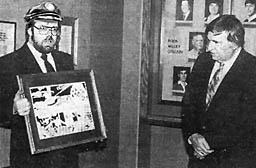
Here I'm gifting a set of original Kulpa art to Star Trek creator Gene Roddenberry during his appearance in Rockford, Illinois back in the 1980s.
When deep, graduated blue hues of the Fantastic Four’s covers gave way to a flat cyan look — and this was reflected across all Marvel’s covers — I quit. I stopped buying. I stopped reading. “This,” I said, “is crap.” They just looked two d*mned commercial.
Also around the mid 1970s, internal pages printed badly, and in some cases, were so muddied as to be virtually illegible. By then, my interest was almost negligible, kept alive by a growing art career, however, I did have some influence on several publications. During the 70s I’d co-create story plots with Warren Publications writer John Jacobson, who would sell these to Joe Orlando for $10 a pop. And one art submission sent on or around 1976 seemed to inspire the Avengers to take a bus — and a supporting character to wear Groucho Marx specs — in an issue appearing three months later. Coincidence? I sent Marvel giant bus ad-rack placard comic strips produced for the Rockford, Illinois Mass Transit System, featuring my own Rockford Avenger, who wore Groucho Marx specs as a disguise.
The rich look and quaint feel of the 1960s comics were gone. Super-sized specials, i.e. the outstandingly-written and illustrated Superman VS Spiderman, DID work for me. But these were few and far between — and waaayyy-too expensive at 50 cents.
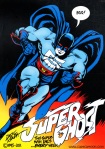
I did not "swipe" Jack Kirby, but I could channel him. This is one of my top comic characters, Superghost
Upon joining DC Comics, personal hero Jack Kirby, went, in my mind, “out of control.” Lacking Joe Sinnott’s stabilizing inks and Stan Lee’s remarkable editorial story-telling disciplines, Kirby’s stuff held little interest for me as a reader. It turns out, I was not alone. Comics blogs now tell me Jack’s work plummeted in popularity back then. And when Kirby “defected” to DC, my emotional attachment to any Marvel “club” vanished. After all, if Marvel’s “king” could up and leave, so much for any fraternity.
So what happened?
I now know that original page sizes were reduced around 1970-71, suggesting that artists, accustomed to bigger paper, suddenly became cramped. One possible reason for the size change? The new 10″ x 15″ size easily fit on Xerox machines. It also appears printers were changed, and more and more “fans” became producers in the comics industry, creating stories seemingly more “in-jokish” and “homage”-oriented (not unlike recent Fantastic Four movies). Artwork sometimes seemed intent on showing off the artist, rather than in telling any story.
A 1979 (or 1980) phone conversation with Vince Colletta yielded this startling advice: “Stay out of comics, kid, all the good writers work for movie companies.”
As comic publications evolved into the slicker, high-quality, computer-colorized,

I'm always trying to "save" things, silly stuff like lives, jobs...and publications. Here I am as "County-Man" -- it was 8 degrees above zero that day.
gadget-ridden budget-busting books of the 90s, I advised fellow fans, “these (books) are too perfect — they’re destined for comic convention 25-cent boxes,” where many did wind up. All that, in spite of the tremendous talent they carried.
As per today’s comics fare? I’ve interacted one-on-one with nearly 20,000 kids the past six years, drawing their caricatures. They’ll sometimes ask me to draw them as superheroes, and seizing the chance, I would ask “Do you read the comics?”
“No,” is their inevitable response. “I saw the movie.”
In my humble opinion, the demise of “The Silver Age of Comics” didn’t happen through osmosis. It took some effort. These fun books mutated into “commercial-looking” enterprises.
Certainly, the near extinction of drugstore spin-racks, coupled with a mass-exodus to specialty comics shops, removed comics from the public eye.
Can a “new Silver age” return? Of course. When comic books become comic books again, re-establishing connection with a younger audience, when “comics” are priced so reasonably that kids — and parents — can willingly afford to take a chance on them, and when “the reader” is placed above all else — including ego — with well-written, grounded stories worth reading.
My own chincey 8-page web-offset faded color Gangbuster comic book confirms kids’ interest in reading comics, every single day. I’ll be handing those out in earnest on “Free Comic Book Day,” and if any publisher has what they believe to be a “mainstream-oriented, back-to-basics, fun-read” comic book they want handed out, send ’em on. They’ll go to a ton of mainstream kids.

A Kodak moment...a boy actually READING a comic book. Carefully, the photographer drifted around him, sizing up that perfect shot, as the boy, oblivious to his surroundings, maintained communion with the story. I've seen this scene many times before -- isn't this what comic books have always been about? This is one of my Gangbuster comics.
Plus get a few more disciplinarian “Jim Shooters” or genius “Stan Lee” clones in there, and watch what happens.
As for me, did I fail? Hell no — a job with the comics industry was just one possible means to an end, and I passed that opp up in 1984.
I’ve had the time of my life!
Captain Cartoon never did get to mow Elvis Presley’s lawn, but he eventually did help bring the King back to life, appearing as Elvis on a Weekly World News cover story in the mid 90s. He served as a key force behind the sale of over 200,000,000 hard copy WWN editions during his tenure. His greatest character creation continues to appear in the Off-Broadway “Bat Boy, the Musical.” The CRACKED Magazine sale was never officially closed, due to a legal conundrum.
Read more about Captain Cartoon here.
Oh — one more thing:

Dick Kulpa was the surprise winner of an online poll conducted in 2004. Though he had attended a number of these conventions in 2003, producing spoof and caricature sketches for fans, Kulpa was unaware that he was even entered in any poll.

